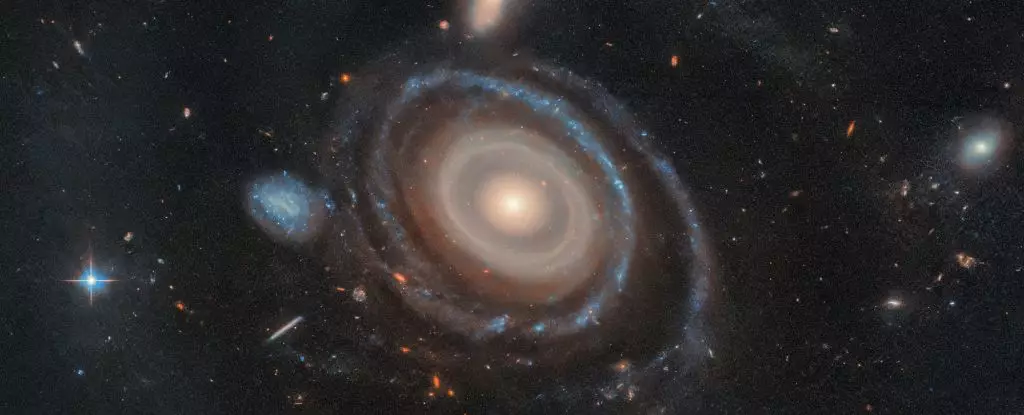In the vast expanse of the cosmos, each galaxy possesses its unique characteristics, akin to how every snowflake and fingerprint is distinct. Yet, the recent discovery of a remarkable galaxy, situated 567 million light-years away, introduces a captivating anomaly to the discourse surrounding galactic formations. Despite the myriad galaxies that populate the universe, none has been confirmed to bear the stunning features of the Bullseye Galaxy, officially designated as LEDA 1313424. This exceptional galaxy is encircled by not one, but nine meticulously arranged concentric rings, showcasing the aftermath of a dramatic interaction with a smaller blue dwarf galaxy that traversed its core. This event has significant implications for our understanding of galactic behavior and the mechanics of cosmic collisions.
The Circumstances Behind the Bullseye’s Creation
The phenomenon of ring galaxies is an exceedingly rare occurrence in the universe, thought to arise under specific conditions. While the universe appears sparse and desolate at first glance, galaxies are often gravitationally bound, aligning along the cosmic web’s filaments, which leads to unexpected collisions. These interactions can manifest in various forms, presenting a diverse range of outcomes. The Bullseye Galaxy serves as a prime example, confirming that these dramatic cosmic encounters can indeed culminate in such striking structures. The intricate arrangement of its rings has intrigued astronomers, offering insights into the mechanics behind these captivating formations.
Moments Captured in Time
According to astronomer Pieter van Dokkum of Yale University, the Bullseye Galaxy is currently undergoing a particularly rare phase, during which it exhibits a pronounced series of concentric rings. This fleeting moment in its lifecycle reveals a unique opportunity for researchers to study the galaxy’s structure and its formation process. Observations suggest that these rings are the result of material being densely compressed by shockwaves triggered during the impact. Understanding this process is essential, as it allows scientists to refine their models related to galactic dynamics and collisions.
Recent observations utilizing the Hubble Space Telescope, in conjunction with the Keck Cosmic Web Imager (KCWI), have provided critical insights into the Bowseye Galaxy and its smaller companion. Engaging with the KCWI, astronomers were able to unveil a significant connection between the two galaxies — a clear stream of gas indicating that the companion galaxy has impacted the Bullseye directly. This groundbreaking revelation was made possible through precise imaging techniques that captured the movement and interaction of gases along the cosmic sprawl. Such observations enhance our understanding of how one galaxy can leave a lasting imprint on another.
The intricacies of the galaxy’s rings are characterized by regions of heightened density, where particles of dust and gas have been compacted due to the shockwaves traveling outward. These regions serve as hotspots for star formation, leading to a vibrant display of cosmic activity and stellar birth. This phenomenon is responsible for the luminescent appearance of the rings, which shine brightly against the dark backdrop of space. The phenomenon can be likened to dropping a pebble into still water, where the resulting ripples create distinct patterns that radiate outward. This analogy helps elucidate how the rings around the Bullseye Galaxy have formed, spacing themselves according to their proximity to the initial impact.
Implications for Future Research
The discovery of the Bullseye Galaxy not only enriches our knowledge of ring galaxies but also poses questions regarding the mechanics of celestial interactions. Astronomers are keen to leverage this data to refine theoretical models and expand their understanding of galaxy collisions. Furthermore, the researchers anticipate that ongoing advancements in telescope technology will facilitate the identification of additional ring galaxies hidden within the vast expanses of the universe. Each new discovery may serve as a testament to the intricate tapestry of cosmic interactions that shape galaxies and ultimately influence the evolution of the universe.
As we stand at the threshold of deeper cosmic exploration, the discovery of the Bullseye Galaxy stands out not only for its striking visual appeal but also for the rich scientific opportunities it presents. As astronomers continue to investigate this and other cosmic phenomena, we may unlock further secrets of the universe — understanding not only how galaxies collide but also how such events contribute to the ongoing process of cosmic evolution. The journey of uncovering the mysteries of our universe is far from over, and each revelation adds a new layer to our comprehension of the cosmos.


Leave a Reply